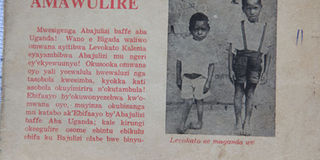The making of Uganda Martyrs

Documented. The Miracle as it was reported in the newspapers then.
What you need to know:
Beatification: Before the martyrs could be beatified as saints, the requirements were that they perform at least two miracles. The martyrs indeed performed the miracles and were later declared saints as Gillian Nantume writes.
Every year in mid May, pilgrims from various walks of life – and countries – begin the difficult but joyous journey, walking from their homes to the Uganda Martyrs Shrine in Namugongo.
The walk is to emulate the torturous journey the martyrs took as they were herded to the place of execution by the chief executioner, Mukajanga, and his team.
Although some people may not know why Martyrs Day is celebrated on June 3, among Christian circles, the day is not a mystery.
Rev Canon Henry Ssegawa of the Anglican Uganda Martyrs Shrine says: “Most of the martyrs who died at Namugongo were executed on Thursday, June 3, 1886. Of course, other martyrs were killed in different places on different days, but the main execution took place on that specific date.”
The beatification of the martyrs
Six months after the last martyr died in 1887, a diocesan tribunal was set up to gather and investigate information about the circumstances surrounding the case.
Nine years later, in 1906, the Cause of Beatification of the martyrs was opened with the requirement being that the dead martyrs should perform at least two miracles before they can be declared saints.
Fortunately, their cause of death classified them for red martyrdom – having died for their faith – which made the process faster.
Bishop Joseph Hirth, the Catholic Bishop of German East Africa, helped to locate the relics of St Charles Lwanga and Matia Mulumba which were buried at Nalukolongo by fleeing Christians. This discovery helped set the process in motion.
Others who initially worked tirelessly to ensure that the martyrs were saints are Fr Timoteo Ssemwogerere and Fr Antonio Wonter, the postulator.
Others are Bishops Henry Stretcher (Masaka), Joseph Cabana, Joseph Kiwanuka (Rubaga), Adrian Kivumbi Ddungu (Masaka) and Cardinal Laurean Rugambwa (Tanzania).
In 1920, Pope Benedict XV beatified 13 Catholic martyrs.
The miracles the martyrs performed
One the earliest recorded miracles that the martyrs performed was in 1941. Two nuns, Sister Aloyse Criblet and Sister Richildis Buck, who were stationed at the Institute of the Missionary Sisters of Our Lady of Africa Rubaga, caught pneumonic plague after taking a group of students to Kisubi for an outing.
Previously, no victim of pneumonic plague had survived. As the nuns were admitted to Rubaga Hospital, the Rt Rev Edward Michaud, the Bishop of the former Rubaga Diocese, ordered the faithful to pray to the Blessed Martyrs for the healing of the nuns. The relics of Lwanga and Mulumba were also placed on the sisters.
Miraculously, the two recovered. Dr I. D. Ahmad, the head of Rubaga Hospital, consulted with a pathologist and Dr R. E. Barret, a medical officer of the British Colonial Government.
The latter testified that never in his experience had a victim of pneumonic plague recovered.
Twenty years later, in 1961, the martyrs performed their second recorded miracle when Revocato Kalema, a crippled child from Kyotera, regained the function of his legs.
According to Kalema’s friend, Augustino Mukiibi, Kalema’s mother had died in childbirth.
“The baby looked strange, like there were no bones in his legs. As he grew up, he could not sit, crawl, or talk. He just lay on a mat all day.”
Some school girls took the baby to the Sisters of Bwanda Convent in Bigada, and in 1961, when Bishop Joseph Kiwanuka of Masaka Diocese announced that believers should pray for miracles to be performed through the martyrs, students in Bigada began a nine-day novena at Bigada Cathedral. Every day, they placed Kalema at the altar where the relics of the martyrs were kept.
On June 14, 1961, three days before the end of the novena, the two and a half-year-old Kalema began crawling. By evening, he was walking.
The miracle was verified by the Vatican and documents in the Archives of Rubaga Cathedral in a book titles ‘So Abundant a Harvest’ by Yves Tourigny.
On October 18, 1964, the martyrs were proclaimed Saints by Pope Paul VI at St Peter’s Basilica in Rome.
To commemorate the canonisation of the martyrs, at the invitation of Emmanuel Cardinal Nsubuga, Pope Paul VI visited Uganda in 1969 to bless the Uganda Martyrs Basilica in Namugongo.
750 foot pilgrims set off for Namugongo
More than 750 pilgrims from Lira Catholic Diocese set off for Namugongo Martyrs Shrine last Thursday, ahead of this year’s celebrations. The pilgrims, comprising mainly elderly women and men, were flagged off by Bishop Joseph Franzelli of Lira Diocese at 1am.
During the evening mass on Wednesday that preceded the flag off, Bishop Franzelli appealed to all Christians to use this year’s celebrations to renew their faith in God and desist from perceiving their journey as a mere tour to Namugongo.
The bishop also urged the pilgrims to pray for faith renewal and reconciliation.
“Go and ask for the renewal of faith, love and unity among us because we are of one family, we serve one God. We want peace but we are unable to achieve this on our own. Let us go and ask the Lord of Uganda Martyrs to give us this gift,” he said.
BY ISAAC OTWII




